With standard tyres on your harvester, you will rapidly reach the limits in terms of bearable load or maximum pressure.
These limits are a nuisance during harvesting and you will lose time emptying the hopper more often or sometimes have to stop operations if the trailer rotations are not correctly synchronised.
Yet there is a simple solution to increase the load by 70% and continue work with less frequent unloading. The solution requires specifically designed harvester tyres which offer a cyclic load of 14 tonnes more on the front axle.
But make sure you respect the 3 following conditions to be able to make use of this additional load capacity without harming your tyres.
Does your harvester need specific tyres?
Harvesting is the campaign that requires the heaviest equipment, for which you must absolutely check your tyres and adapt pressure based on load.
- An empty harvester with its cutting bar weighs around 24 tonnes.
- The hopper can contain between 8,000 and 15,000 litres of grain.
- This can result in a load ranging from 6,700 kg to 12,600 kg depending on the density of the grain and the moisture content.
- Which is a little over 37 tonnes in total.
With the front cutting bar and the hopper full, the weight distribution is around 75% on the front and only 25% on the rear axle.
If we take the loads in the example above, that makes approximately 14,000 kg on each front tyre.
What are the physical limits of your tyres?
If you check the maximum load specified by your manufacturer for your standard tyres, you will easily find that the level of weight in the example above is much higher than the maximum specified, even with maximum inflation pressure.
You only have one solution, to half-fill the hopper, with more trips back and forth with the trailer required and an overall loss of time for the harvesting campaign.
Another possibility would be to equip your harvester with specific harvest tyres, which are designed to resist cyclic variations in load of up to +70%, while respecting the three rules below:
1. To increase the load on the harvester tyres, you must reduce speed
Speed is not compatible with very heavy loads
Each tyre has a speed rating linked to a load index marked on its sidewall.
This indication is very important because it gives you the nominal load and speed provided by the manufacturer, who has tested your tyre model and established, as a result of these tests, that this load associated with this speed is the optimal setting to work rapidly without damaging your equipment.
It’s a reference point, which means that you can load more if you reduce speed or increase speed if you reduce the load.
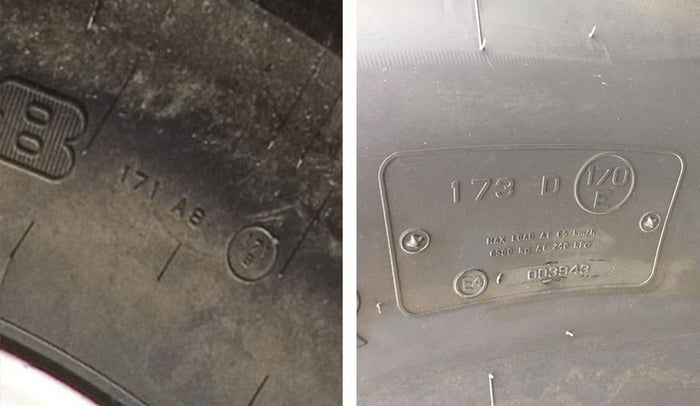 171 on the left and 173 on the right correspond to the load index and A8 or D is the speed rating
171 on the left and 173 on the right correspond to the load index and A8 or D is the speed rating
(see manufacturer load/speed rating tables for data in kg and km/h)
What happens in the case of excess speed?
You have noticed that the load squashes the tyre into the ground. This deformation of the tyre is accentuated if you increase the load.
The travel speed determines the time your wheel will take to complete a full turn. For each rotation, the tyre must imperatively have the time to get its original shape back before coming back into contact with the ground and undergoing a further deflexion.
If this is not possible (due to excess speed) the deformation of the tyre will amplify until the casing breaks.
The Maxi Traction Harvest tyre allows you to work with a bonus load of 70%
Reducing speed is one of the main ways to be able to increase load considerably. Here is an example with the specialist Maxi Traction Harvest tyre made by FIRESTONE.
You need great reliability of the tyre in terms of load capacity to obtain such a difference, which is possible for this specific model that has been reinforced structurally with a greater number of plies.
Front tyres 900/60 R32 Maxi Traction Harvest:
- For a speed of 40 km/h the maximum load per tyre is 8,250 kilos for a pressure of 3.2 bar.
- However, at a speed of 10 km/h the maximum load with the same tyres is 14,025 kilos with a pressure increased to 4 bar.
i.e. a bonus load of 70% respecting the 2 other slope and maximum distance criteria described below.
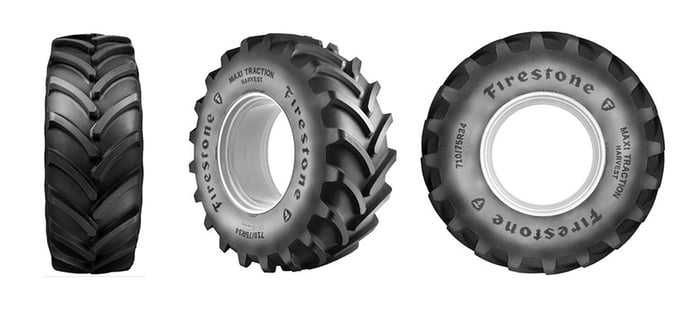 FIRESTONE’s Maxi Traction Harvest tyre
FIRESTONE’s Maxi Traction Harvest tyre
2. To increase the load on harvester tyres, you must never drive on a slope of more than 20%
The bonus load is not compatible with steep inclines
As harvesting equipment is very heavy and has to cope with cyclic loads during the filling and unloading of the hopper, its tyres are placed under considerable strain.
If you want to obtain the 70% bonus load described in the preceding examples, you must take the slope of the land into account. The degree of inclination of the slope has a direct impact on the tyres positioned lower down.
The crushing of the tyre linked to the cyclic load effectively increases more on the lower tyres. The maximum tolerance is 11 degrees, which is a 20% gradient.
In addition, there is a serious risk of the tyres coming off the rims because excess pressure is transferred to the sidewalls below.
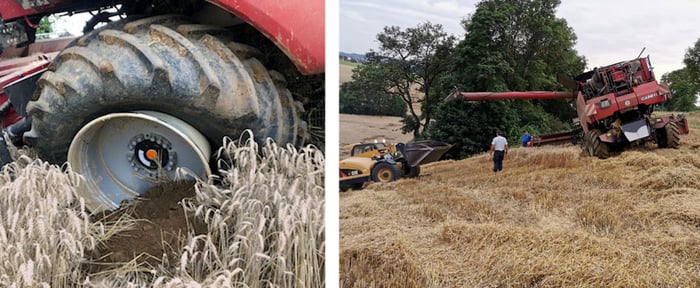 Tyre coming off the rim of a harvester
Tyre coming off the rim of a harvester
due to the load being incompatible with the slope
3. To increase the load on harvester tyres, you must limit the distance driven
Unlike with the tractor, you cannot adjust pressure to correspond precisely to your load, because the load fluctuates.
There may be a difference in weight of around 12,000 kg when the hopper is fully loaded. It is your tyres alone that compensate for this excess load.
Naturally, it’s when the load limits are exceeded that the quality of the tyre’s construction and its structure are extremely important.
In the example above, the 900/60 R32 tyre goes from 8,250 kg at a pressure of 3.2 bar to a load of 14,025 kg and a pressure of 4 bar. This is a gain of more than 5,700 kg.
This excess load cannot be constant, because it would have too great an impact on the internal structure of the tyre. This is why the distance you can drive with the maximum bonus load is only 1.5 km, which allows you to save precious time before unloading into the trailer.
Conclusion
There are two maximum cyclic load capacities for different speeds with FIRESTONE’s Maxi traction Harvest tyres.
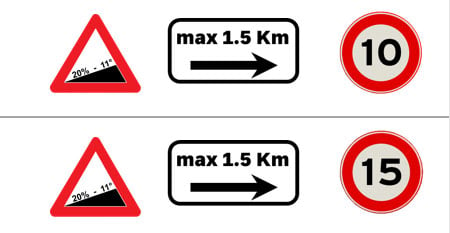 Limits to respect for a cyclic load during harvesting
Limits to respect for a cyclic load during harvesting
To obtain a bonus load of +70%:
you must increase inflation pressure by 25% and drive no faster than 10 km/h, as well as respecting maximum slope and distance criteria.
To obtain a bonus load of +55%:
you must increase inflation pressure by 25% and drive no faster than 15 km/h, as well as respecting maximum slope and distance criteria.
This Harvest tyre has been designed and developed to work with a very advantageous bonus load to save time during harvesting.
If you respect these three conditions, you will not alter the characteristics of the tyre, which will be able to work for thousands of hours without becoming excessively worn.
For more information on tractor tyres
With Firestone, you have the guarantee of tractor tyres that deliver a real advantage, and that in choosing our brand, you can work worry-free.
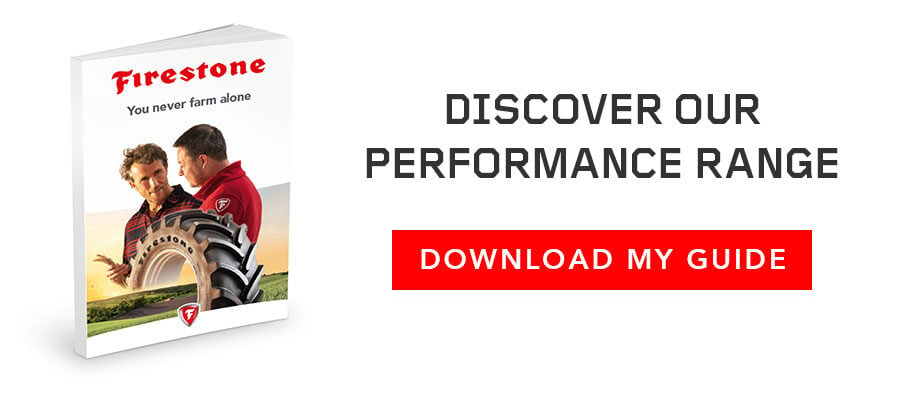
Most people who read this article have also read some of the following articles:
This information is intended only to make you aware of the technical and functional aspects of agricultural tires and their use. It does not allow you to make a judgment or a definitive conclusion on a given problem. Only your agricultural tire expert is able to make a technical assessment and take a final decision, case by case.